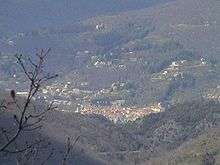Le Vigan, Gard
| Le Vigan | |
|---|---|
| Subprefecture and commune | |
 Le Vigan and the Arre River | |
 Le Vigan Location within Occitanie region  Le Vigan | |
| Coordinates: 43°59′35″N 3°36′22″E / 43.9931°N 3.6061°ECoordinates: 43°59′35″N 3°36′22″E / 43.9931°N 3.6061°E | |
| Country | France |
| Region | Occitanie |
| Department | Gard |
| Arrondissement | Le Vigan |
| Canton | Le Vigan |
| Intercommunality | Pays Viganais |
| Government | |
| • Mayor (2008–2014) | Eric Doulcier |
| Area1 | 17.24 km2 (6.66 sq mi) |
| Population (2008)2 | 3,964 |
| • Density | 230/km2 (600/sq mi) |
| Time zone | UTC+1 (CET) |
| • Summer (DST) | UTC+2 (CEST) |
| INSEE/Postal code | 30350 /30120 |
| Elevation |
184–640 m (604–2,100 ft) (avg. 231 m or 758 ft) |
|
1 French Land Register data, which excludes lakes, ponds, glaciers > 1 km2 (0.386 sq mi or 247 acres) and river estuaries. 2 Population without double counting: residents of multiple communes (e.g., students and military personnel) only counted once. | |

View from the mountains to Le Vigan
Le Vigan (French pronunciation: [lə viɡɑ̃]; Occitan: Lo Vigan) is a commune in the Gard department in southern France. It is a sub-prefecture of the department.
Geography
Le Vigan is located at the south of the Massif Central and near the Mont Aigoual, in the Arre valley.
Population
| Historical population | ||
|---|---|---|
| Year | Pop. | ±% |
| 1793 | 3,852 | — |
| 1800 | 3,834 | −0.5% |
| 1806 | 3,983 | +3.9% |
| 1821 | 4,303 | +8.0% |
| 1831 | 4,909 | +14.1% |
| 1836 | 5,049 | +2.9% |
| 1841 | 4,938 | −2.2% |
| 1846 | 5,128 | +3.8% |
| 1851 | 4,993 | −2.6% |
| 1856 | 4,656 | −6.7% |
| 1861 | 5,376 | +15.5% |
| 1866 | 5,104 | −5.1% |
| 1872 | 5,024 | −1.6% |
| 1876 | 5,389 | +7.3% |
| 1881 | 5,268 | −2.2% |
| 1886 | 5,353 | +1.6% |
| 1891 | 5,374 | +0.4% |
| 1896 | 5,199 | −3.3% |
| 1901 | 5,126 | −1.4% |
| 1906 | 4,595 | −10.4% |
| 1911 | 4,744 | +3.2% |
| 1921 | 4,221 | −11.0% |
| 1926 | 4,274 | +1.3% |
| 1931 | 4,278 | +0.1% |
| 1936 | 3,704 | −13.4% |
| 1946 | 3,676 | −0.8% |
| 1954 | 3,867 | +5.2% |
| 1962 | 4,111 | +6.3% |
| 1968 | 4,207 | +2.3% |
| 1975 | 4,293 | +2.0% |
| 1982 | 4,517 | +5.2% |
| 1990 | 4,523 | +0.1% |
| 1999 | 4,429 | −2.1% |
| 2008 | 3,964 | −10.5% |
Economy
As with many towns in the Cévennes, there were many textile industries there in the past. Several quarries south of town above Montdardier were formerly important sources of lithographic limestone. Stone from these quarries earned an honorable mention in the Great Exhibition of 1851.[1]
Le Vigan is a tourist destination during summer time.
Personalities
- Chevalier d'Assas (1733–1760)
- Sergeant Triaire (1772?-1799)
- Caroline Proust Actress (1967-)
- Constituant Quatrefages de la Roquette
Sights
- The musée cévenol shows the life in the Cévennes during the past centuries
- The Vieux Pont is an old bridge built during the 11th century
- The old hotel Faventines called Château d'Assas from 18th century
- The Arboretum de la Foux and Arboretum de l'Hort de Dieu are mature arboretums
See also
References
- ↑ Class I, Report on Mining, Quarrying, Metallurgical Operations, and Mineral Products, Reports by the Juries on the Subjects in the Thirty Classes Into Which the Exhibition was Divided, Exhibition of the Works of Industry of All Nations, 1851, Clowes, London, 1852; page 28.
External links
| Wikimedia Commons has media related to Le Vigan (Gard). |
This article is issued from
Wikipedia.
The text is licensed under Creative Commons - Attribution - Sharealike.
Additional terms may apply for the media files.